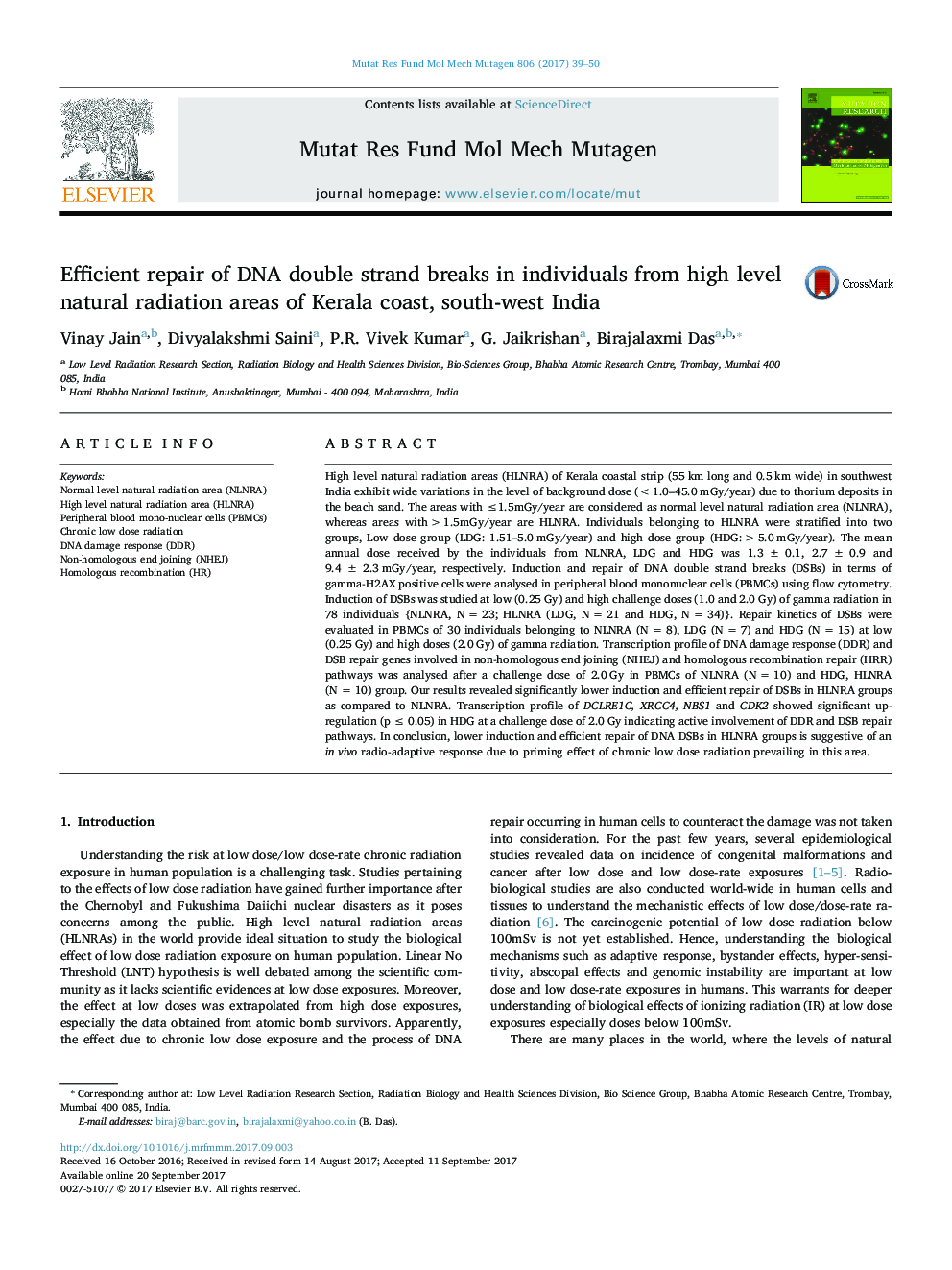| کد مقاله | کد نشریه | سال انتشار | مقاله انگلیسی | نسخه تمام متن |
|---|---|---|---|---|
| 5528652 | 1548302 | 2017 | 12 صفحه PDF | دانلود رایگان |

- Induction and repair of DSBs were evaluated in NLNRA and HLNRA (LDG and HDG) individuals using gamma-H2AX as a marker.
- Significantly lower level of induction of DSBs observed in the HDG comprising of HLNRA individuals (>5.0Â mGy/year) at low challenge dose (0.25Â Gy).
- NHEJ and DDR genes are significantly up-regulated in HDG of HLNRA after a challenge dose of 2.0Â Gy.
- Efficient repair of DSBs in HLNRA groups is suggestive of in vivo radio-adaptive response due to priming effect of chronic low dose radiation.
High level natural radiation areas (HLNRA) of Kerala coastal strip (55 km long and 0.5 km wide) in southwest India exhibit wide variations in the level of background dose (< 1.0-45.0 mGy/year) due to thorium deposits in the beach sand. The areas with â¤1.5mGy/year are considered as normal level natural radiation area (NLNRA), whereas areas with >1.5mGy/year are HLNRA. Individuals belonging to HLNRA were stratified into two groups, Low dose group (LDG: 1.51-5.0 mGy/year) and high dose group (HDG: >5.0 mGy/year). The mean annual dose received by the individuals from NLNRA, LDG and HDG was 1.3 ± 0.1, 2.7 ± 0.9 and 9.4 ± 2.3 mGy/year, respectively. Induction and repair of DNA double strand breaks (DSBs) in terms of gamma-H2AX positive cells were analysed in peripheral blood mononuclear cells (PBMCs) using flow cytometry. Induction of DSBs was studied at low (0.25 Gy) and high challenge doses (1.0 and 2.0 Gy) of gamma radiation in 78 individuals {NLNRA, N = 23; HLNRA (LDG, N = 21 and HDG, N = 34)}. Repair kinetics of DSBs were evaluated in PBMCs of 30 individuals belonging to NLNRA (N = 8), LDG (N = 7) and HDG (N = 15) at low (0.25 Gy) and high doses (2.0 Gy) of gamma radiation. Transcription profile of DNA damage response (DDR) and DSB repair genes involved in non-homologous end joining (NHEJ) and homologous recombination repair (HRR) pathways was analysed after a challenge dose of 2.0 Gy in PBMCs of NLNRA (N = 10) and HDG, HLNRA (N = 10) group. Our results revealed significantly lower induction and efficient repair of DSBs in HLNRA groups as compared to NLNRA. Transcription profile of DCLRE1C, XRCC4, NBS1 and CDK2 showed significant up-regulation (p â¤Â 0.05) in HDG at a challenge dose of 2.0 Gy indicating active involvement of DDR and DSB repair pathways. In conclusion, lower induction and efficient repair of DNA DSBs in HLNRA groups is suggestive of an in vivo radio-adaptive response due to priming effect of chronic low dose radiation prevailing in this area.
Journal: Mutation Research/Fundamental and Molecular Mechanisms of Mutagenesis - Volume 806, December 2017, Pages 39-50